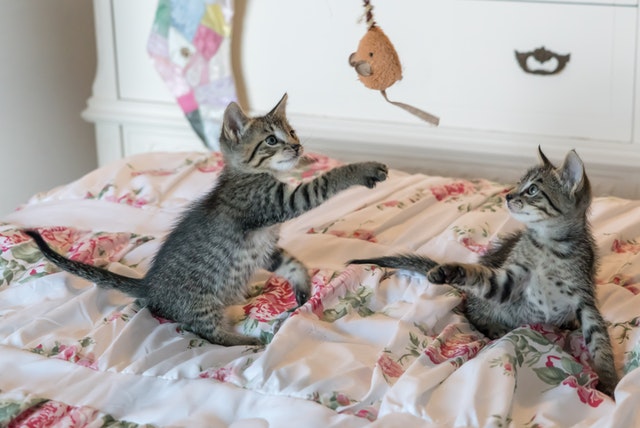How to communicate with your cat is probably the most asked question by cat owners. Indeed, most cat owners use human languages to communicate with their pets, forgetting that these adorable little creatures have their own way of communication.
It is not just a Meow! This usually results in losing communication with your cat and reinforcing the widespread belief that cats don’t listen, even if they just ignore you.
This is not true, because if you want to communicate with your cat, you better speak their language. Cats depend mainly on body language to talk about their needs or just their emotions.
I know that communications with cats can be difficult sometimes, but enjoying an adorable companion does not come for free. As a cat owner, it is essential to put some effort into understanding your cat and communicate with it.
In this article on how to communicate with your cat, we will provide you with some tips to improve the way you talk with your pet and understand them. Also, you will find a small guide that may help you to decode your cat’s body language.


Table of Contents
The Relation Between Animal Communication And How To Communicate With Your Cat!
Wikipedia explained, Animal communication as a way to transfer information from one group of animals to another, which is defined within two groups (Senders) and (Receivers). This event between senders and receivers affect the current or the future of the behavior of the receivers.
This definition was precise not to include speaking as part of transfers of the information between animals because only humans practically can communicate using “speaking,” which means there are other ways to communicate between one group of animals and another.
Overall, we conclude that any method, including Visual, Auditory, Olfactory, Electric, Touch, Seismic, Thermal, can be a great way to communicate with other groups of animals.
Therefore, to understand your cat better and begin actually to talk to it, you have to learn how to communicate with your cat using different methods. Speaking is not the main one! Therefore, we are going, to begin with, a mini-guide of your cat’s vocal language and what it means.
A Mini-Guide Of Your Cat’s VOCAL Language – How To Communicate With Your Cat Using Their Vocal Language.
Indeed, the cat’s language is not just a Meow, but Meowing is part of their language. Some cats can be pretty vocal. In this case, you need to understand what it is saying to master how to communicate with your cat.
The following guide is, of course, general and may not correspond to your cat’s context. So while translating your cat’s vocalization, pay attention to the contest.
#1 A Little Meow:
A little Meow is like a Hello or a “wassup mate.” When your cat wants to greet you and begin a new day with you beside it, your cat will make sure to let you know about that. A little Meow is your cat’s way to say, Hi! However, some cat owners may wonder how to understand this little Meow and differentiate it from other Meows. It is easy once you get used to it. Just pay more attention.
“If cats could talk, they wouldn’t.” –Nan Porter
#2 Constant Meowing:
This may articulate happiness. Even though constant Meowing articulate happiness, some cat owners confuse it with loud Meow or other types, which might mean your cat is anxious or annoyed about something. It is for the best to make sure it is not a different type of Meowing.
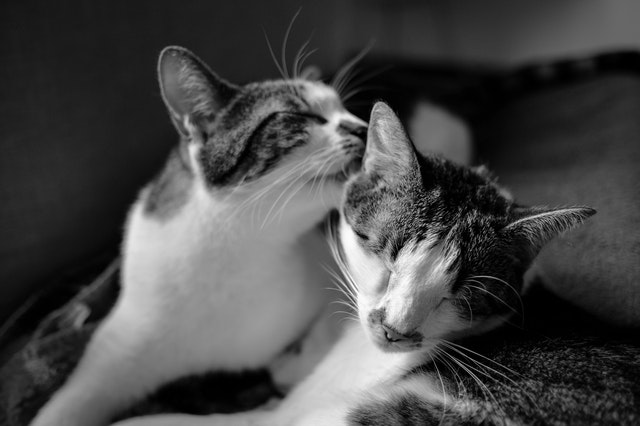

#3 Loud Meowing:
Cats usually meow loudly when asking for food, especially when they are hungry.
#4 Mid-Pitched Meowing:
Mid-pitched Meowing also means asking for something, but it is not as necessary as begging for food.
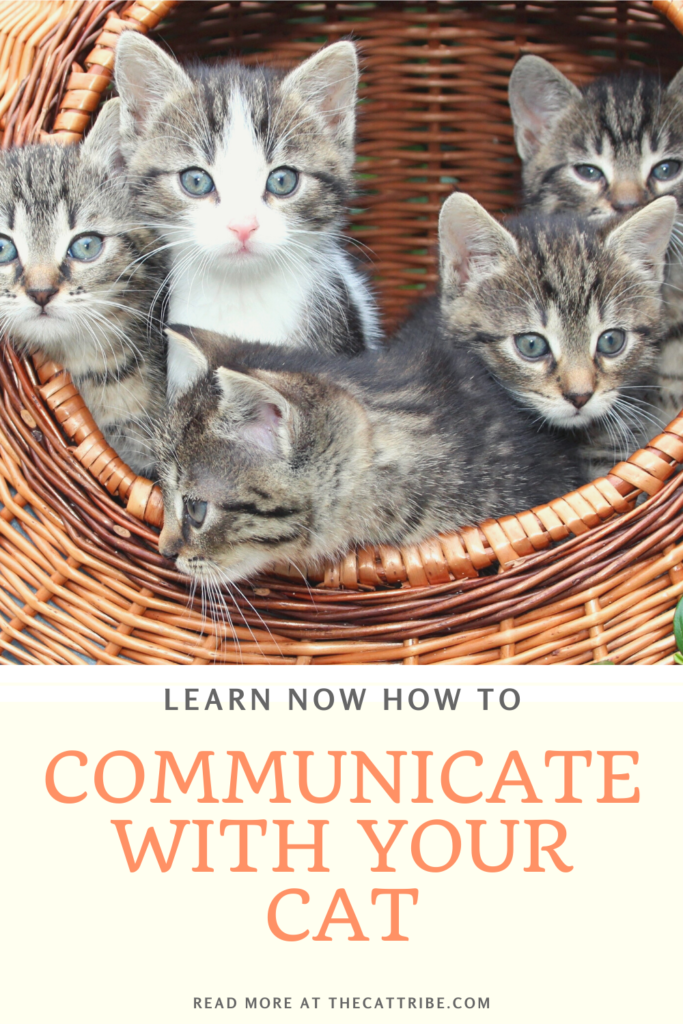
#5 High-pitched Meowing:
Cats usually do these specific vocalizations when they are unsatisfied, so you better figure out what you have done wrong before it is too late.
#6 Purring
Now, this is a bit confusing, because it may indicate that your cat is happy in some cases. In other situations, it may mean that your cat is afraid of something or in pain. So it would be best if you regarded the context before decoding your cat’s purring.
Grab Your Gift From Our Freebies Page! Click Here
A mini-guide of your cat’s BODY Language – How To Communicate With Your Cat Using Their Body Language.
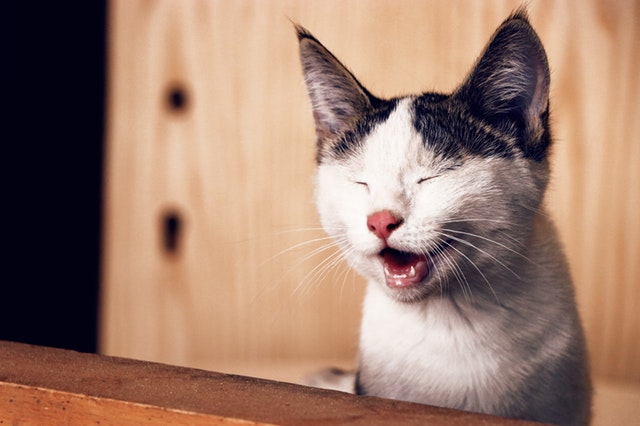

Understanding your cat’s body language is highly crucial. Some cats are not vocal when it comes to communicating with you about their needs, and they depend entirely on their body language.
The following interpretations of the cat’s body language will help you answer the question of how to communicate with your cat.
#1 Your Cat’s Tail
The tail is an essential part of cats’ body language. We can tell so much about how a cat is feeling by the position of its tail. When your cat is happy and cheerful, its tail should be in a straight-up position with a little curl at its end.
Also, if its tail is vibrating, your cat is probably excited to see you. Usually, when you come home at the end of the day, this is the tail position you should see, if you don’t, then something is wrong, and you should fix it.
Sometimes cats express excitement. They twitch their tails, yet this is also done when they are anxious, so you should consider the context before interrupting the tails move.
On the other hand, the tail position is a good indicator if your cat is angry or getting aggressive. In this situation, the tail fur will stick up, and the tail curl will be in the shape of an N.
Sometimes the tail curl will be held low, in such a case, your cat might be frightened or getting aggressive, or getting aggressive because she is frightened.
Whatever the case is, you should not let your cat involve humans and try to calm it down as possible. If you are unable to do so, you can always seek professional help.
To sums things up:
Your cat will position and move its tail as a signal to help you understand its needs as following:
- Your cat will straight-up its tail and curl at the end to show happiness.
- Your cat will twitch its tail as a sign of excitement and anxiety.
- The fur on your cat’s tail will be bushy or sticking up when your cat feels playful, excited, or threatened.
- Your cat’s tail will be vibrating when your cat is happy and excited to see you.
- Your cat’s tail fur sticks straight up and the tail curls in the end in the shape of N if your cat feels aggressive and ready to fight.
- Your cat’s tail fur straight up, but it is held low if your cat is aggressive or frightened.
- Your cat’s tail is held low and tucked it under its rear if it feels frightened.

#2 Your Cat’s Eyes
In the cat’s planet, there is a saying that says, “eyes are the windeow of the soul.” Only real cats’ owners, like us, will know how true this is for what we have seen when our cats let us sneak a peak form their eyes.
Well! If your cat hasn’t given you a sneak peek yet, keep reading as we guide you on how to communicate with your cat through its eyes.
When your cat’s eyes are expanded and wide, it means that your cat is excited. If your cat blinks continuously, it means that it is showing you love and affection.
If you notice these behaviors often, it means you are close to getting a sneak peek of its soul.
- If you notice your cat’s eyes dilated while staring at them, either means a good sign or bad one. Dilated pupils can be seen when your cat is playful and excited OR aggressive and fearful.
- If your cat is staring at your eyes, that is an excellent sign of your cat’s trust towards you. Also, it means that your cat is comfortable around you.
- Your cat blinking eyes slowly may show affectionate. If your cat is blinking slowly, that means your cat is showing Affectionate.
#3 Your Cat’s Head
Yes! The head can be very expressive, as well. Usually, cats rub their head against stuff to claim ownership; it is usually combined with licking or kissing, which is also another sign of affection and love.
When it comes to ear movement, when they are pinned back, your cat is probably anxious or scared.


How To Talk Cat!
Now that you understand some of your cat’s language, you can now communicate back a little with your little fluffy one. It would be best if you keep in mind that it is not the words that you will say that your cat understands.
After all, cats are not humans; they are better, I know, but they are not humans, so that words won’t work. The secret to how to communicate with your cat is all about the tone of your voice and your gestures.
Also, consistency is your way to perfect communication with your pet. If you keep changing the tone of your commands or your hand gestures or just give up too quickly, your cat will get confused and won’t obey you.
Also, remember that cats are different than dogs. You can’t simply search on the internet for a good training program to teach them how to obey you. It would be best if you communicated with your cat to achieve that. And that’s how to communicate with your cat.
Also, it is essential to listen carefully to what your cat is saying. Try to observe its different body language in different contexts and pay attention to the different tones of its Meowing.
Of course, you can use the Meow guide above, but each cat is different and needs to be studied subjectively to interrupt its body language right.
Moreover, you can use your cat’s body language in your favor and communicate with it. We mentioned earlier that cats love to slow-blink as a form of affection and love, so you can imitate this gesture to show your cat some love.
Remember that cats love blinking, but they get so irritated and threatened when you are staring at them. So while you’re winking at them, make sure you never stare. You can do this love blinking when your cat is relaxed, and who knows you may get some love back.
Furthermore, you can also imitate how cats greet each other and greet your cat the same way. If you have noticed, cats often greet each other by touching the nose.
You can imitate this by shaping your index to the shape of a nose and extending your hand slowly. If you do so, your cat may greet you in a way that makes sense to it.
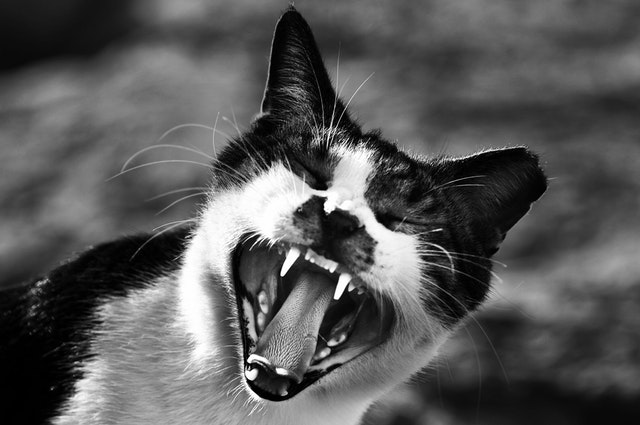
Conclusion
Understanding your cat’s behavior and communication skills is a great way to improve your relation with your cat/. Also, it is a way to strengthen your relationship with your cat.
Cats are different than dogs in expressing what they need and want. Also, they will always make sure to make it clear for what they need. All you have to do as a cat owner is to listen and pay more attention to your cat! Also, don’t forget to do the wet nose kiss!
Finally, I hope you found this article about how to communicate with your cat useful and informative.
Let me know your answer down below. What do you think about these tips to communicate with your cat? Do you have more information or tips about cat language or how to improve communication with cats?
If you have any other questions or different opinions about it, leave a comment below.
Don’t Forget To Follow Us On Our Social Channels. View Here

